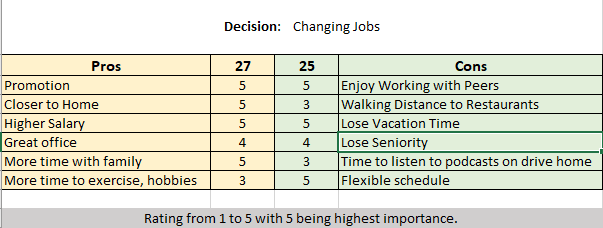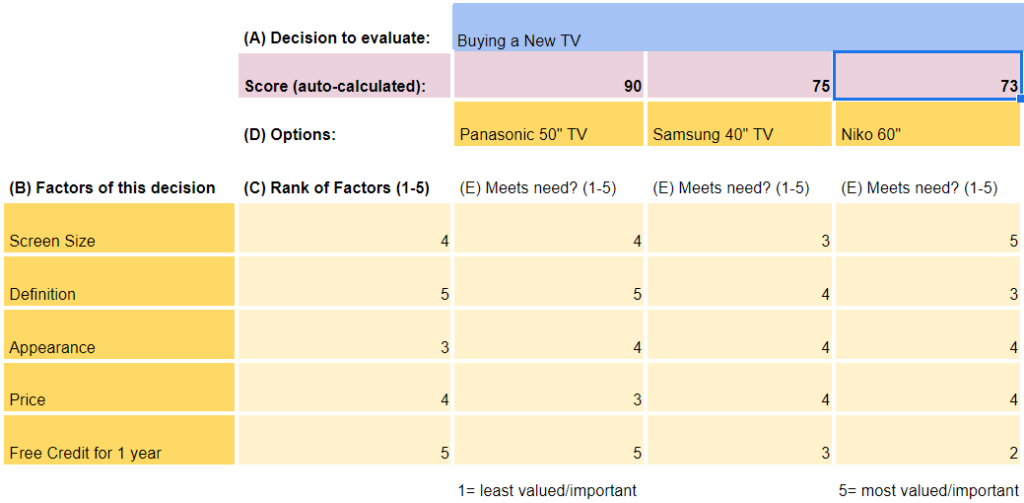How to Solve Problems Using ‘Pros and Cons’ Lists
- Posted by
- Posted in Leadership, Personal Development, Uncategorized
Professional or Personal Problems come in all shapes and sizes, but one of the most common types of problems is needing to choose between two possible solutions. In these cases, you may find yourself forced to pick between two equally viable options.
When this happens, you may end up trapped in indecision. Often this doesn’t mean picking between two things at all. Rather, you may need to decide between taking action or remaining stuck, keeping things the same versus making a change.
Fortunately, this is a common problem and there are some readymade solutions you can count on. One of these is the classic answer – a pros and cons list.
Using the List
As you know, the theory behind a pros and cons list is to make arguments for and against a certain idea or action. For example, say you are struggling with the idea of whether or not to leave your current job. You might make a list of advantages and disadvantages of leaving. Or maybe you’re deciding between two televisions for your home, the columns would instead be for each television and you’d write down the pros of each one.
You would then score each reason under each column and based on the highest score, you would have your answer, at least in theory.
Taking it to the Next Level Using Spreadsheets
The problem with the basic pros and cons list is that it tends to be qualitative rather than quantitative. In other words, just counting how many ‘pros’ an option has doesn’t really tell you whether this is the best alternative or not.
Instead, you need to, at the very least, quantify each score as well. This is where using a spreadsheet can come in handy. A spreadsheet allows you to enter a score for each answer which you choose based on its relative importance in making the decision. Now the final score would give you a much better idea of how you really felt about each alternative.
Here’s an example of how this works for changing jobs. Note that your pros or cons for taking a job may differ. The ‘cons’ side is the perks that you’d possibly miss if you left your current job while the ‘pros’ is what you are hoping to gain.

As you can see, the ‘pros’ actually win, but not by much. Still, in the example above, you would most benefit by switching jobs. Check out this site for a free template which provides you with a link to download a version of this.
A more detailed version of a decision spreadsheet is one where you score a particular question along with the ranking of the importance of that question. Here’s an example of comparing buying a new TV.

As you can see, the column under “Rank of Factors” shows how much each of those criteria matters where 5 is the most important and 1 being least. In the example above, you can see that definition or image quality is very important along with getting interest free credit for 1 year. This is weighted most so in those categories, the TV that offers this will have a higher score. In the example above, the Panasonic ranked the highest with a score of 90. Here’s a link to this free template.
These are 2 ways to upscale the pros and cons list so that you can get a more definitive answer to your options. Many company buyers or purchasing decision-makers use one of these strategies to help narrow down their decision. Maybe you can see why this is a valuable way to help solve some tough problems.
Consider using one of these tools with your team if there are decisions that require group collaboration and compromise. You can generate some pretty powerful and insightful conversations by discussing the merits of certain features/benefits of each option. It may even allow you to learn more about what your team members value as well as their opinions of the problem and possible solutions.
What other tools have you used to help you make more qualitative decisions? Have you ever used a similar tool and how has it worked for you?
It is my hope that as leaders, we find a way to make better and more effective decisions in a shorter amount of time. Problems and their solutions can help to move the needle forward, if done correctly.
To your spirit infused leadership!
Recent Posts
- 5 Tips for Getting Undesirable Emotions Under Control
- Do What You Love- Love What You Do
- How Discovering Your Purpose Can Make You Happy
- How Gratitude Can Improve Your Business
- Find Your Passion in 5 Easy Steps
Categories
- Customer Service (3)
- Goal Setting (11)
- Inspiration (15)
- Leadership (28)
- Personal Development (43)
- Sales (3)
- Uncategorized (11)
